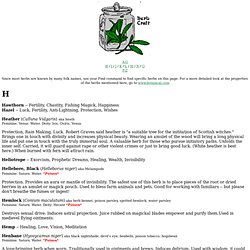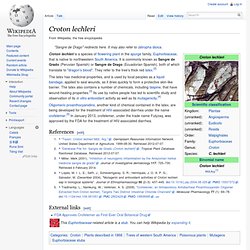

Bromileads. Morning Glory's. Dragon's blood. Dragon's blood, powdered pigment or apothecary's grade and roughly crushed incense Name and source[edit] Dragon's blood resin is also produced from the rattan palms of the genus Daemonorops of the Indonesian islands and known there as jerang or djerang.

It is gathered by breaking off the layer of red resin encasing the unripe fruit of the rattan. The collected resin is then rolled into solid balls before being sold. The red latex of the Sangre de Grado tree (Croton lechleri), native to north-eastern South America, has wound-healing and antioxidant properties, and has been used for centuries by native people. Uses[edit] The dragon's blood known to the ancient Romans was mostly collected from D. cinnabari, and is mentioned in the 1st century Periplus (30: 10. 17) as one of the products of Socotra. Dragon's blood of both Dracaena draco (commonly referred to as the Draconis Palm) and Dracaena cinnabari were used as a source of varnish for 18th century Italian violinmakers.
See also[edit] Magickal Herbs H-O. Since most herbs are known by many folk names, use your Find command to find specific herbs on this page.

For a more detailed look at the properties of the herbs mentioned here, go to www.botanical.com Hawthorn -- Fertility, Chastity, Fishing Magick, HappinessHazel -- Luck, Fertility, Anti-Lightning, Protection, Wishes Heather (Calluna Vulgaris) aka heath Feminine. Venus. Water. A Witches Garden- Herbs and Plants Every Goddess Should have at her Disposal. 13 herbs a witch should have by Raven Grimassi by Pagans Southern California (Pagans of Southern California) on Myspace. Calamus rotang. Calamus rotang aka rotang is one of the scandent rattan palms used for Malacca cane in the making of furniture, baskets, walking-sticks, umbrellas, tables and general wickerwork, and is found in Southwest Asia.

The basal section of the plant grows vertically for 10 metres or so, after which the slender, tough stem of a few centimetres in diameter, grows horizontally for 200 metres or more. It is extremely flexible and uniform in thickness, and frequently has sheaths and petioles armed with backward-facing spines which enable it to scramble over other plants. It has pinnate, alternate leaves, 60-80 cm long, armed with two rows of spines on the upper face. The plants are dioecious, and flowers are clustered in attractive inflorescences, enclosed by spiny spathes. Croton lechleri. Croton lechleri is a species of flowering plant in the spurge family, Euphorbiaceae, that is native to northwestern South America.

It is commonly known as Sangre de Grado (Peruvian Spanish) or Sangre de Drago (Ecuadorian Spanish), both of which translate to "dragon's blood". They refer to the tree's thick red latex.[2] The latex has medicinal properties, and is used by local peoples as a liquid bandage, applied to seal wounds, as it dries quickly to form a protective skin-like barrier. The latex also contains a number of chemicals, including taspine, that have wound-healing properties.[3] Its use by native people has led to scientific study and observation of its in vitro antioxidant activity as well as its mutagenicity.[4] References[edit] Jump up ^ "Taxon: Croton lechleri Müll. External links[edit] FDA Approves Crofelemer as First-Ever Oral Botanical Drug. Dracaena draco. Not to be confused with Dracaena cinnabari, the Dragon Blood Tree native to Socotra (an island near Yemen).

Dracaena draco, the Canary Islands dragon tree or drago, is a subtropical tree-like plant in the genus Dracaena, native to the Canary Islands, Cape Verde, Madeira, and locally in western Morocco, and introduced to the Azores. It is the natural symbol of the island of Tenerife, together with the Blue Chaffinch.[3] Dracaena draco in Vila Nova Sintra, Island of Brava, Cape Verde. Description[edit] Dracaena draco is a monocot with a tree-like growth habit currently placed in the asparagus family (Asparagaceae, subfamily Nolinoidae).[4] When young it has a single stem. Being a monocotyledon, it does not display any annual or growth rings so the age of the tree can only be estimated by the number of branching points before reaching the canopy. Uses[edit] The Guanches worshiped a specimen in Tenerife, and hollowed its trunk into a small sanctuary.